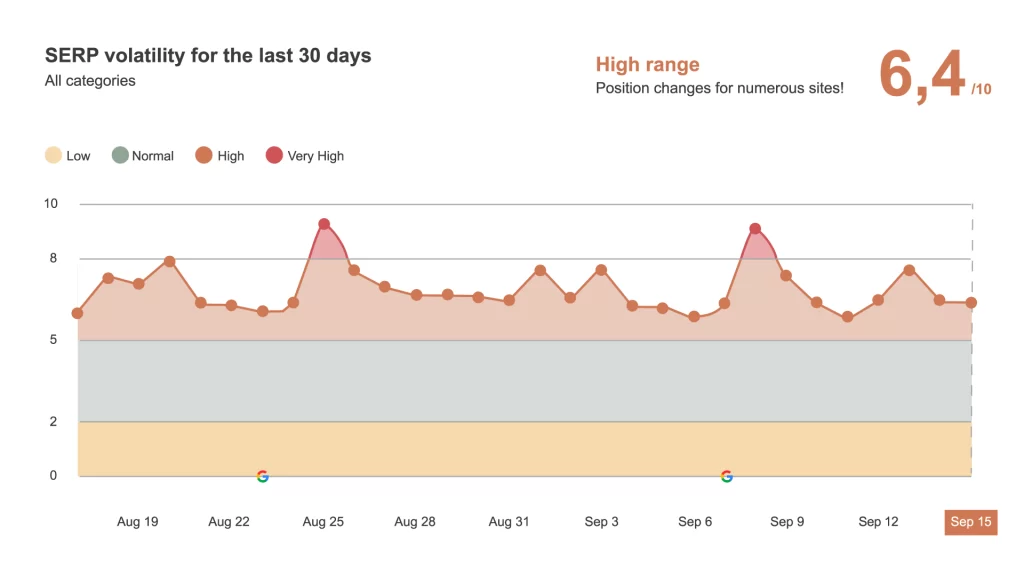Impact of Google’s Core Updates on website positioning: how to prepare, and possibly recover. Let’s analyze the August 2023 update

When we type a keyword in the Google search bar, we must consider that the so-called SERP (Search Engine Results Page) can show variable results over time. In fact, it is not certain that one, or more, of the sites we view today will also be present in the list of results tomorrow.
On the one hand, this happens because sites change, new news spreads or particular events occur: sites and pages can, therefore, gain or lose relevance for specific keywords. On the other hand, it is Google itself, which by updating its algorithms, modifies elements and weight of the parameters considered in the positioning (for example loading times, authority and so on) of one site rather than another.
What are Google Core Updates and what impact do they have on websites
As we know, Google periodically updates its algorithms. The aim is to make search results increasingly precise in responding to user needs, and to propose useful, reliable content coming from the most authoritative sources.
But not only. The pages of the website must also be accessible quickly and easily by the user. In fact, Google also takes into consideration the times and methods of loading the site; in 2020 it introduced the Core Web Vitals, a set of metrics that “measure the real user experience relating to loading performance, interactivity and visual stability of the page”, and whose weight (in terms of importance) is sometimes re-evaluated and re-calibrated during search engine updates.
To understand the “dynamism” of the algorithms, just think that in 2020 Google made as many as 4,500 changes to the SERP mechanisms. An average of twelve per day.
Among all these updates, some have more relevance than others: the so-called Core Updates (or Broad Core Updates). These are updates to the algorithms released “to improve search overall and to keep pace with the changing nature of the web”; they therefore do not focus on a specific aspect or target, but have global value (i.e. they apply to all versions of Google existing worldwide).
The goal of the Core Updates is to provide results that:
- are responsive to specific research;
- offer reliable, updated and complete content;
- guarantee an overall positive browsing experience.
What does this mean for websites?
As we have explained, the Core Updates have the aim of improving the SERPs, and this inevitably affects the positioning of the sites that compose them. Content that is well positioned for particular keywords can, therefore, move back a few positions, or even pages, following updates. Conversely, it is possible to watch content that is considered particularly compliant with the quality criteria of the EEAT paradigm and therefore rewarded with positioning among the first results shown.
It is important to consider, however, that any loss of positioning following a Core Update is not to be considered a penalty, or “punishment”, by the search engine.
On the occasion of the May 2022 Core Update, Google had in fact communicated: “If some pages experience poorer performance following a major update, this is not an indication of a problem. It doesn’t mean they violated our spam policies or were subjected to manual or algorithmic action, as can happen with pages that violate these guidelines. In fact, there is no aspect of a major update that is targeted to specific pages or sites; the changes instead concern how our systems evaluate content overall. Because of these changes, the performance of some pages that were previously not rated as highly as they deserved may improve.”
How to prepare for Core Updates
For all of the above, the need to be prepared when dealing with Google updates is clear, in order to avoid finding yourself with pages that cannot be found in the SERPs. On the contrary, the objective is to ensure that, thanks to the updates, the SEO and user-focused work carried out on the site and contents is progressively enhanced.
It therefore emerges how important it is to plan an SEO activity and take into consideration the overall user experience from the early stages of a site’s development.
For this reason, digital agencies make use of experts in the development of sites and in the communication of the commercial offer. It is essential to involve a front-end developer, or a UX designer, to design a clear and linear structure, and allow the user to better navigate and orient himself among the contents of the site, with an attractive design that can entice the user to navigate between the various pages and sections. In all of this, however, attention must also be paid to loading performance so that, regardless of the connection or device used, the contents can be viewed quickly and easily.
The latter must in turn be planned according to the actual information needs of the user for whom they are intended. In this case, professional figures such as SEO Specialist – for the analysis of searches and the competitive landscape – and copywriters – for the drafting of clear and captivating contents, with the right tone of voice – are essential to avoid finding yourself with a site that does not communicate correctly to the public.
Based on Google’s positioning criteria, we know that the classification of content occurs based on the following parameters:
- relevance: checks that the proposed content is in line with what the user is looking for;
- quality: rewards content that highlights skills, authority and reliability;
- usability: ensures that contents are accessible, even from mobile devices, and load quickly.
Contacting an agency or professionals in the sector is the best solution to ensure that your offer of products and services reaches the public in an optimal way, as well as to avoid “bad surprises” following a Google update.
Recover lost ranking after a Core Update
Did Google do a Core Update and our traffic dropped? For those keywords thanks to which we were in the top positions on the SERPs, do we notice that our place is now occupied by competitors? Let’s see what to do.
First of all, it is good to remember what was stated previously: if our site has suffered a drop in positioning, there is not necessarily something wrong, but rather it could be that there is some content similar to ours which is more worthy of occupying the top positions. positions.
To clarify this concept better, on the occasion of the August 2019 update Google explained as follows: “Imagine creating a list of the 100 most popular films of 2015. After a few years, in 2019, update this list; the changes you make will be completely natural: some new films that didn’t exist before will be candidates for inclusion in the list, while perhaps you reevaluate others and decide that they deserve a better position than before. The list will change: if the position of some films drops in the ranking compared to before, it does not mean that they are poor, but simply that there are more worthy titles.”
It is important, therefore, to know which elements Google considered most worthy of the update. Since it is unusual for the search engine to immediately make the details of the changes made known, in this sense the comparison between digital professionals becomes very useful, who, by collecting and sharing the information, are able to understand the parameter scheme favored by the search engine.
Another very important aspect to understand what happened is to take a look at our competitors, in particular at those who have positioned themselves well in the SERP for the same keywords. It is necessary to evaluate which technical and content elements, as well as authority and user experience, for which that content was considered more worthy by Google than ours.
Also in this case, it is advisable to evaluate the support of specialized figures, such as SEO Specialists. In fact, they are able to study each individual case as best as possible and, with the help of specific tools, evaluate the right interventions to make to improve positioning in user searches.
The importance of staying updated
Staying up to date on SEO, and more generally on the digital marketing landscape, is of fundamental importance to obtain good results from your project. Keeping up with the latest trends and best practices means being able to easily adapt to changes in the industry and search engine algorithms, turning potential threats into opportunities.
If you want an overview of Google updates, it is interesting to consult the Google Search Status Dashboard, a page through which the search engine presents a summary of the various changes made to the algorithm over the years. In an ever-evolving digital world, staying up to date on SEO practices is key to being able to compete and achieve successful results.
A recent case: August 2023 Core Update
A recent case of Core Update dates back to August 2023. This update, which began on August 22nd and ended on September 7th, involved various areas globally. As can be seen from the graph below, extrapolated with Semrush Sensor, there are peaks in the volatility of the SERPs close to the two dates.

According to the analyzes on the sites, it appears that the update followed the direction of the EEAT paradigm, therefore promoting exhaustive and authoritative content, which proves the author’s real experience.
However, those contents written in an inaccurate manner or through the use of generative AI, or which simply report facts without contributing added value, were penalised. In this case, if a site has suffered declines, it is important to proceed with an analysis of the keywords and related pages, carefully evaluating the quality of the content and identifying specific interventions to make it a resource of greater value and improve the user experience.